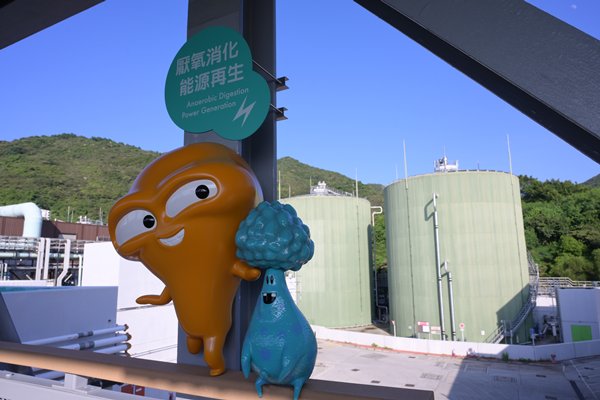Turning Food Waste Into Energy

Nestled in North Lantau is organic resources recovery centre O.PARK1, the first facility in Hong Kong which converts food waste into electricity. In March this year, the O.PARK1 Visitor Centre opened its doors to the public by offering guided tours.
Through the visitor centre, the Environmental Protection Department said it hopes to introduce the public to the Government’s strategies on food waste management, promote a food wise and waste less culture as well as encourage households and the commercial and industrial sectors to reduce food waste at source.
After arriving at the visitor centre and listening to a brief introduction from the tour guide, participants are led to the O · CLUB dome theatre to watch a series of informative computer animations.
Waste-to-energy
Iconic mascot Big Waster is presented in 360-degree projection and 3D mapping technology explaining how food waste increases the pressure on landfills, the process of converting food waste into electricity and introducing O.PARK1’s
facilities.
O.PARK1 adopts anaerobic digestion technology to convert food waste into biogas. The combined heat and power generation units then combust the biogas to generate electricity.
The department’s Assistant Environmental Protection Officer Daniel Chau noted that O.PARK1 can handle a maximum of 200 tonnes of food waste every day.
“Excluding the electricity required for the operation of O.PARK1, a maximum of 14 million kWh of electricity can be exported to the power grid of the electricity company every year,” Mr Chau added.
Green promotion
After leaving O · CLUB, participants follow the tour guide to three attractions. The first stop is a photo opportunity with a model of Big Waster at O · WELL. This is followed by a stroll along the O · LINK for a closer look at the facility’s equipment and systems, before ending the tour at the O · FARM rooftop garden to appreciate the horticulture.
Shrubs in O · FARM and all the gardening within the facilities are nurtured by compost products made in-house. Compost is the by-product generated from recycling food waste at O · PARK1.
O.PARK1 Visitor Centre Manager Monica Kwok explained that the facility distributes some of the compost to government departments and local landscaping companies. All tour participants also receive a bag of compost as a souvenir so they can share in the benefits of food waste recycling.
The visitor centre offers four guided tours daily, except on Tuesdays when it is closed. The tour lasts for about one and a half hours and is available in either Cantonese, Putonghua or English.
To book a free guided tour, visit the O.PARK1 website.
Hotline Eases Carers' Burden
Mrs Lee, 74, and her 84-year-old husband are a doubleton elderly household relying on Comprehensive Social Security As... Read more
District Governance: Cameras Boost Security
Whether at busy intersections or tranquil street corners, Hong Kong has silent sentinels safeguarding citizens. Thr... Read more
Meals Tailor-made For Patient Needs
The bustling kitchen of Kowloon Hospital serves approximately 1,400 inpatients per meal. The menus are designed to ... Read more
Talent Volunteers Share In Festive Fun
Staged ahead of the Mid-Autumn Festival, a lantern workshop organised by the Talent+ Volunteer Programme, run by Hong ... Read more
Hydrogen Paves Low-carbon Future
Hydrogen energy is regarded as a low-carbon energy with development potential, as the world is striving to phase out f... Read more
Drones Offer Medical Delivery Hope
Transportation to Cheung Chau has always depended on ferries, which are subject to scheduling constraints. In the even... Read more

